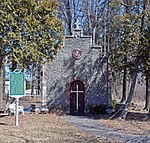Lake St. Clair Metropark
Lake St. Clair Metropark/Metro Beach Metropark is a 770-acre unit of the Huron-Clinton Metroparks system located roughly 20 miles (32 km) northeast of downtown Detroit, Michigan in Harrison Township, Macomb County. Lake St. Clair Metropark has been in existence since 1950 and has seen many changes since then. Originally named St. Clair Metropolitan Beach, it was renamed in 1953 to Metropolitan Beach Metropark and later shortened to Metro Beach Metropark. On December 8, 2011, the Board of Commissioners for the Huron-Clinton Metroparks approved changing the name to Lake St. Clair Metropark. The park is located at Jefferson Avenue and Metropolitan Parkway (16 Mile Road) and there are signs to Lake St. Clair Metropark on Interstate 94 (I-94). Due to sewage overflows, Metro Beach has seen occasional closures caused by high E. coli content in the water. The beach was closed for nine days in 2009 for this reason.
Excerpt from the Wikipedia article Lake St. Clair Metropark (License: CC BY-SA 3.0, Authors).Lake St. Clair Metropark
Metropolitan Parkway,
Geographical coordinates (GPS) Address Nearby Places Show on map
Geographical coordinates (GPS)
| Latitude | Longitude |
|---|---|
| N 42.57569 ° | E -82.7993 ° |
Address
Metropolitan Parkway
48045
Michigan, United States
Open on Google Maps







